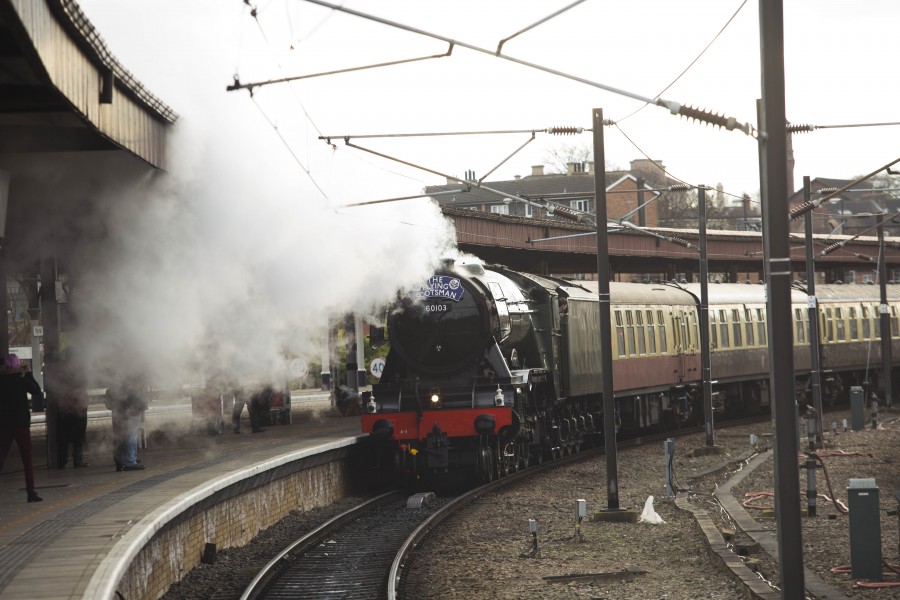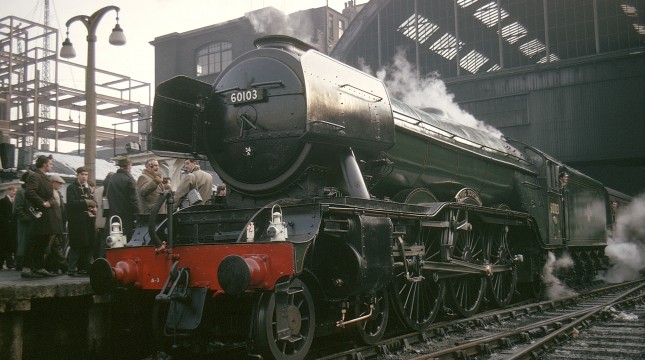Flying Scotsman in the Spotlight

From spotlight to sidelines, Flying Scotsman’s career has been anything but a smooth ride. The 25th February saw the highly anticipated return of the iconic locomotive after a painstaking £4.2m restoration.
Designed by renowned steam locomotive engineer Sir Nigel Gresley and built at Doncaster Works in 1923, Flying Scotsman was the flagship locomotive of the new London & North Eastern Railway (LNER). The LNER ensured instant celebrity status for the new star of their fleet by naming it after the renowned express train service between London and Edinburgh, and debuting it at the British Empire Exhibition in Wembley in 1924 (and again in 1925). Seen by millions in its eye-catching apple green livery, it was heralded as a symbol of modernity in the brave new world emerging from the shadow of the First World War.
The ‘Flying Scotsman’ brand maintained its enviable position at the forefront of the public consciousness thanks to a string of record-breaking feats performed by the locomotive star, including hauling the first non-stop service between London and Edinburgh in 1928, a starring role in the first British talkie movie (aptly called The Flying Scotsman) in 1929, and becoming the first locomotive to achieve an authenticated 100mph run in 1934.
Wartime workhorse, scrapyard survivor
With the advent of the Second World War, the steam star was transformed into a wartime workhorse. The loco’s previously iconic number 4472 became 103, and like the rest of the LNER fleet, it hauled heavier loads, was maintained less regularly, and was painted in Wartime Black to avoid being targeted by the enemy.
After the war, the fame and favour bestowed on the once-beloved locomotive declined. It was no longer an aspirational symbol of the modern age, but an outdated relic of a bygone era. In 1962 the LNER celebrated the centenary of the Flying Scotsman service by displaying a Deltic at King’s Cross station, the fastest and most powerful of the new diesel locomotives, and sent its former pride and joy away from the celebrations to avoid sending an outdated message to the public. With Flying Scotsman no longer needed to promote its namesake service, it faced the scrapyard along with many other steam locomotives once BR unveiled its modernisation plan sweeping steam away.

Flying Scotsman at King’s Cross, 1963. Photo Credit: North Yorkshire Moors Railway
Comeback kid, sixties globetrotter
One witness to Flying Scotsman’s exile from the centenary celebrations at King’s Cross was Alan Pegler, a British businessman, entrepreneur and railway preservationist, who wrote that he “felt very sorry for 60103”. Indeed, Pegler felt such sympathy for the beleaguered loco that he engineered a last minute reprieve that once again brought it back to the public’s attention. Pegler bought Flying Scotsman outright in 1963, and then had it restored to its former apple green glory at Doncaster Works. Huge public interest and publicity surrounded the restoration process. Renumbered 4472, Flying Scotsman became the comeback kid of steam, a symbol of the 1960s railway preservation movement inspired by nostalgia for Britain’s railway past.
True to form, the locomotive legend exited the swinging sixties in style, setting off on a tumultuous three-year tour of the United States accompanied by a train including an English pub carriage, a Pipe Band Major, a Winston Churchill impersonator (a relative of the man himself), a bus and a group of tartan mini-skirted models.
Although Pegler and Scotsman’s American exploits brought them international fame, the tour eventually left Pegler bankrupt and the locomotive impounded on an army base. Thanks to British businessman Sir William McAlpine, Flying Scotsman returned to Britain via the Panama Canal and arrived to a hero’s welcome.
With the advent of the 1980s, the globe-trotting icon added yet another stamp to its passport with a tour of Australia, where it racked up yet more records. It smashed the world’s non-stop steam record, travelling a remarkable 442 miles in 1988. It then became the first locomotive to circumnavigate the globe when it returned from Australia to the UK via Cape Horn.

Flying Scotsman in North Yard at the National Railway Museum Photo Credit: National Railway Museum
A modern day national treasure
In 2004, Flying Scotsman hit the headlines again with yet another crisis over its ownership. A campaign spearheaded by National Railway Museum to save the locomotive for the nation amassed the support of thousands, confirming its status as a national treasure. Since 2006, Flying Scotsman has been undergoing an extensive restoration in the workshop of Riley & Son (E) Ltd. It is now in the very last phases of the painstaking £4.2m project to bring the legend back to life, resplendent in its BR green livery in its guise as 60103.
As the restoration process comes to an end, all eyes are – once again – on the world’s most famous locomotive. The next chapter in the Flying Scotsman story is its triumphant return as a working museum exhibit, conquering yet another record as the oldest mainline working locomotive on Britain’s tracks. Undoubtedly one of the jewels in the crown of the museum’s world-class collection, it will now be presented to a new generation of Scotsman fans captivating the public for generations to come.
For more information about Flying Scotsman Season please visit www.nrm.org.uk/flyingscotsman/scotsman-season, or track the conversation using the hashtag #FlyingScotsman.
- For more information visit nrm.org.uk
- Follow us at twitter.com/railwaymuseum
- Join us at facebook.com/nationalrailwaymuseum






Leave a Comment